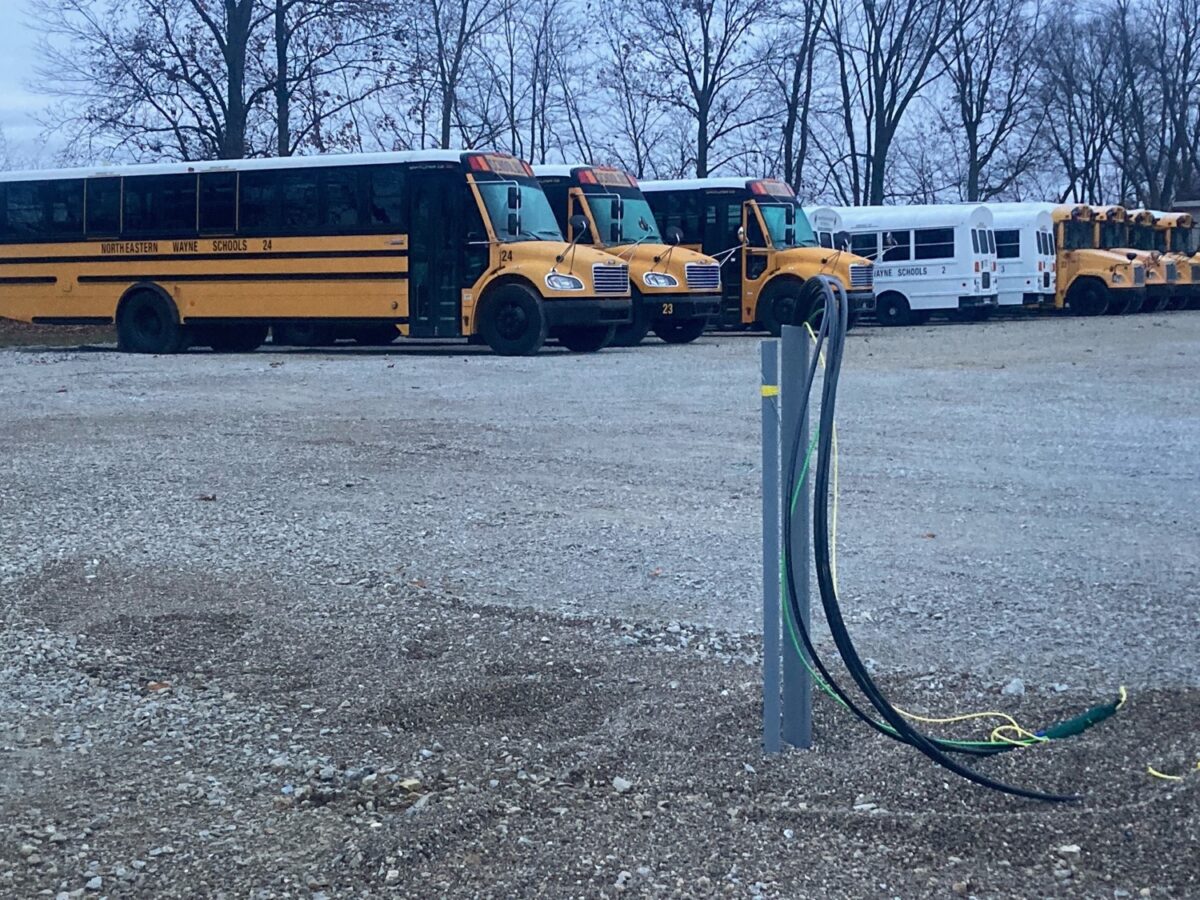Northeastern Wayne School Corporation’s participation in a national experiment with electric vehicles is already ahead of schedule.
The district expects to receive the first of six new electric school buses by Dec. 31, with another five coming by the end of February. That’s several months earlier than expected.
“We thought we had all the time in the world” to prepare for the new buses. “Then all of a sudden, a truck shows up and delivers a charger,” Matthew Hicks, school superintendent, said in October. It pushed forward the school district’s preparations schedule, with charging stations now under construction.
“Our team has had to create space on our bus lot for the buses, add size to the gravel lot, run wiring for the infrastructure, and we will pour concrete for the chargers,” Hicks said.
The district is spending about $100,000 in preparation, with some of that cost being paid through the grant. Completion of the concrete work had been planned before Thanksgiving but rain has delayed it.
Northeastern expects to have all six electric buses picking up and dropping off students by the end of this school year.
Northeastern schools received notification in late 2022 that the federal government is providing a $2.37 million grant to buy six battery-powered school buses. Northeastern is the only Wayne County district to receive the funding.
Regular diesel or gas-powered school buses cost about $250,000 to $300,000 less than the electric buses, but are less energy efficient and emit health- and environment-harming pollution. Diesel exhaust contains chemicals and particulate matter that can affect lung function, cause tiredness and nausea, and lead to increased risk of lung cancer and increased asthma severity.
Part of the reason Northeastern is participating in this program is to see if the savings from not having to buy petroleum-based fuel will make up the cost differential.
“Each bus is $435,000 and Northeastern is covering approximately $60,000,” Hicks said. “The rest is covered by a federal rebate through the EPA Clean School Bus program.”
School officials received help preparing for the new buses through the electric utility serving Northeastern Schools, Whitewater Valley REMC, and its power provider, Hoosier Energy. Hicks says they “have been great partners.”
The REMC placed a new transformer to assume the load for the chargers and is partnering on data research to find the best times to charge the buses and to see if two-way usage is possible, he said.
WWVREMC’s president and CEO, Mary Jo Thomas, said REMC has “sufficient capacity in place currently to serve the chargers for the buses. No additional capacity is needed for this project.”
“As soon as we can keep [the buses] charged, we will start to rotate them” into service, Hicks said. All six will probably be carrying students to and from Northeastern’s three-school campus by the end of the current school year.
He expects the electric battery on each bus will be able to travel about 300 miles before needing recharged. Buses will be parked for overnight charging at the transportation hub on the Northeastern campus. Many of the current buses are already parked there overnight.
Northeastern and REMC are both eager to see how the program works over the coming years.
“The expectations for the buses are that we are able to prove the concept that an EV bus can work in a district like ours and realize a significant cost savings on fuel/energy costs,” Hicks said. “The hope is that the cost to charge the buses will be less than the cost to fuel a traditional diesel bus. On paper, it should be. We have to see what the elements do to us, but we hope to prove a savings over time.”
Thomas said, “There has been a national push toward electrifying the automotive industry. The electric industry views this as both an opportunity and a challenge. The industry has been carefully following the trends and analyzing available data.”
Hicks said Northeastern and WWVREMC will be keeping data on charging and usage: “We are not required to share this with the government, but we would if it helps other districts in the future.”
The grant requires Northeastern to share how it disposes of the old buses.
WWVREMC is watching the experiment closely, as it might provide some insights on how increased numbers of electric vehicles will affect service and rates, Thomas wrote in an email.
The number of fully electric and electric-gasoline hybrid vehicles in Wayne County is about 1.33% of the 376,931 motor vehicles registered in the county, according to 2018-23 totals provided by the Indiana Office of Energy Development. In the other five counties served by WWVREMC, they are around 1% of the total.
“Currently, we have very few members (customers) with EVs (electric vehicles). However, we are looking to the future goals of the automotive industry and including in our future work plans the potential for increases in EV penetration in our territory,” Thomas wrote. “We don’t see significant EV use in our area for many years, giving us time to plan.”
A version of this article appeared in the November 29 2023 print edition of the Western Wayne News.

